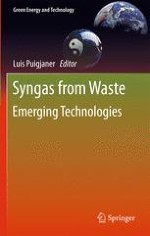Syngas from Waste presents the most recent concepts, methods and techniques for the preliminary design of a promising emerging technology: production of clean syngas from waste materials. An in-depth account is given of the steps necessary to achieve the optimum design and up-to-date tools are presented to support the designer’s decision-making tasks: modelling, simulation and optimization. Numerous illustrations and tables are included to facilitate the reader’s understanding, as well as suggestions for further reading. The text is complemented with practical examples and industrial applications ranging from clean power generation to complex combined heat and power systems and high purity hydrogen for use in fuel cells.
Syngas from Waste contains high-quality contributions from leading experts in the field. It is intended for academics at MSc or PhD level, researchers and industry practitioners in syngas production and applications, who are involved in the design, retrofit design and evaluation activities of alternative scenarios. It contains valuable teaching material for lecturers and provides industry professionals with the know-how to evaluate and improve existing installations or even to design a new one.
